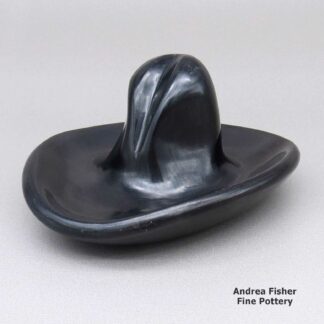Tourist trade
The Tourist Trade
The "tourist trade" was a market segment that opened up from the 1880s into the 1960s. At first, pueblo potters were selling their wares at nearby train stations. Then, as national roads began to develop, trade moved to the sides of those. US Highway 66 was first established in 1926 and it ran near Las Vegas, through Santa Fe and across all the pueblos along the Rio Grande between Santa Fe and Albuquerque. It was a boon to the potters of Cochiti, San Felipe and Santo Domingo. Then the route was re-aligned directly through Albuquerque in 1937 and that northern loop was cut out. That didn't stop all the potters formerly selling along that road: there was still regular traffic, just not as many tourists.
A large segment of the tourist trade was the ceramic trinket market: ashtrays, cigarette lighter cases, shot glasses, cowboy hats, salt-and-pepper shaker sets, figurines, baskets, etc. Some potters also made and sold their regular products but prices had to be low enough that they would sell when someone stopped at a stand on the side of the road, yet high enough that a few sales could support whole families. Every pueblo potter with easy access to a major road could participate, and many did.
The cost-of-living was different back then. And on the pueblos, most families grew their own food. So selling a few $5 ollas could support a family for weeks. The war years saw fewer tourists but roadside sales continued. What supported families through those years was so many of their boys in the military, many of whom didn't come back.
That roadside aspect of the tourist trade business pretty much ended with the opening of the Interstate Highways in New Mexico and Arizona. Some of the major routes across the Navajo Nation still sport roadside sales pavilions, as do several other places in Arizona where masses of tourists stop to get out and have a look-see at the natural environment. Some of today's potters still tell stories of their mothers and grandmothers selling pottery on the side of a highway somewhere.
Maria Martinez never sold a pot on the side of the road. Many of her early pieces sold for $3-$5 each, once she started signing them. After participating in several major national exhibitions, she was quite famous for her black-on-black products. At those prices in the early 1920s, she was able to buy one of the first Model Ts in New Mexico, with cash. As time went on, her prices rose but Maria's pottery was never counted among the tourist trade pottery: she had her place under the portal at the Palace of the Governors in Santa Fe and she did a brisk business there. That said, she did make a few "touristic" items and she usually sold them there. Most tourists and travelers in Santa Fe still meet their first pueblo potters face-to-face under that same portal at the Palace of the Governors. Only certified authentic Native American artists are allowed to sell there.
Showing the single result
Showing the single result
